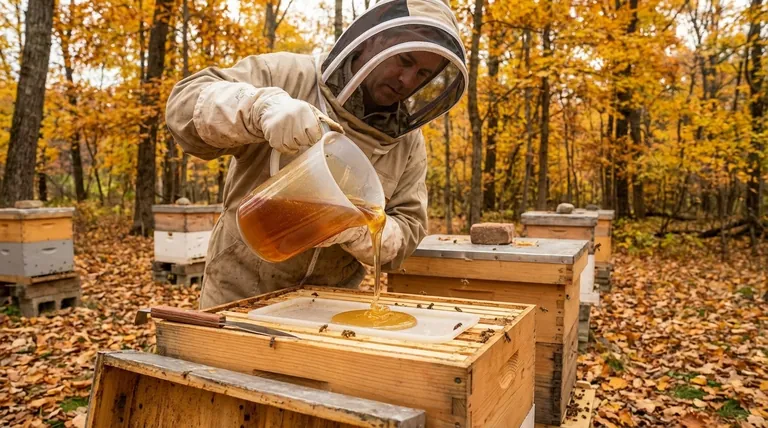The definitive sugar-to-water ratio for fall bee feeding is 2:1. This heavy syrup consists of two parts granulated white sugar to one part water, measured by weight. This specific concentration is designed to help your bees efficiently build up their winter food stores before the cold weather sets in.
The core principle is simple: fall feeding is for storage, not stimulation. A thick 2:1 syrup provides a concentrated energy source that bees can easily process into capped honey, minimizing their workload as the season ends.

The Purpose of a 2:1 Fall Syrup
The shift from a 1:1 spring ratio to a 2:1 fall ratio is a deliberate strategy based on the colony's seasonal needs. Understanding the "why" behind this change is crucial for effective hive management.
Building Winter Stores Efficiently
A heavy 2:1 syrup is the most effective way to help a colony stock its pantry for winter. The high sugar concentration means bees can store more energy with less effort.
This is critical if the hive's natural honey stores are insufficient to last until the first spring nectar flow.
Reducing the Bees' Workload
Syrup is not honey. Bees must process it by fanning their wings to evaporate the excess water content until it reaches the ~18% moisture level of cured honey.
A 2:1 syrup has significantly less water than a 1:1 syrup. This means the bees expend far less energy dehydrating it, a vital conservation of resources as temperatures drop.
Aligning with the Natural Season
In nature, late-season nectar flows are typically thicker and higher in sugar content than early spring flows.
Feeding a 2:1 syrup mimics this natural trigger, signaling to the colony that it's time to stop expanding the brood nest and focus exclusively on storing food for the winter.
Understanding the Critical Difference: 2:1 vs. 1:1
Using the wrong syrup at the wrong time can send your colony the wrong signals, with potentially damaging consequences.
Fall Syrup (2:1) for Storage
The goal of this heavy syrup is to be stored and capped. Its thickness discourages the queen from laying more eggs, which is desirable as the colony needs to shrink to a smaller, more manageable winter cluster.
Spring Syrup (1:1) for Stimulation
A lighter 1:1 syrup (one part sugar to one part water) mimics an early spring nectar flow. This stimulates the queen to begin laying eggs and encourages the colony to build comb and expand its population. Using this thin syrup in the fall is a mistake.
Common Pitfalls to Avoid
Proper preparation and timing are just as important as the ratio itself. Avoid these common errors to ensure your feeding is effective.
Measuring by Volume, Not Weight
The 2:1 ratio must be calculated by weight. A pound of sugar takes up much more space than a pound of water.
For a precise mix, use a kitchen scale. For example, combine 2 pounds of sugar with 1 pound of water (which is roughly one pint or two cups).
Feeding Too Late in the Season
Feeding should be completed before the weather turns consistently cold. Bees need time to process the syrup and cap the cells before they form their winter cluster.
Aim to finish all fall feeding by the end of September or early October, depending on your climate. Feeding liquid syrup in cold weather can add detrimental excess moisture to the hive.
Boiling the Syrup
Never boil the sugar syrup. Overheating can cause the sugars to caramelize, which creates compounds that are toxic to bees.
Simply use very hot water and stir until the sugar is completely dissolved. The solution will be clear when properly mixed.
Making the Right Choice for Your Hive
Matching the feed type to your specific goal is the cornerstone of responsible beekeeping.
- If your primary focus is building winter food stores: Use a 2:1 syrup (by weight) in early to mid-autumn to ensure the hive is heavy with resources.
- If your primary focus is stimulating spring growth: Use a 1:1 syrup (by weight) after the last frost to encourage brood rearing and colony expansion.
- If your primary focus is emergency winter feeding: Use solid sugar (fondant or sugar bricks) to provide calories without adding dangerous moisture to the cold hive.
Providing your bees with the right nutrition at the right time is the most important thing you can do to ensure their survival and success.
Summary Table:
| Feeding Goal | Recommended Ratio (Sugar:Water) | Key Purpose |
|---|---|---|
| Fall Feeding (Storage) | 2:1 (by weight) | Build winter food stores efficiently |
| Spring Feeding (Stimulation) | 1:1 (by weight) | Stimulate brood rearing & colony growth |
| Emergency Winter Feeding | Solid Fondant/Sugar Bricks | Provide calories without adding moisture |
Ensure your apiary is fully prepared for winter with the right supplies. HONESTBEE supplies beekeeping supplies and equipment to commercial apiaries and beekeeping equipment distributors through wholesale-focused operations. From high-quality feeders to essential hive components, we provide the reliable equipment you need to support your colonies' health and productivity. Contact HONESTBEE today to discuss your wholesale needs and secure your seasonal supplies.
Visual Guide

Related Products
- HONESTBEE Premium Italian Style Hive Tool with Hardwood Handle
- Wooden Bee Brush with Triple Row Artificial Fiber for Beekeeping
- HONESTBEE Advanced Ergonomic Stainless Steel Hive Tool for Beekeeping
- Automatic Honey Flow Beehive 4 Frame Mini Hive for Beekeeping
- Wholesales Dadant Size Wooden Bee Hives for Beekeeping
People Also Ask
- What is required for regular inspections in both Flow Hives and Langstroth hives? Essential Beekeeping Tasks Explained
- What are some common uses of a hive tool? Essential Multi-Purpose Tool for Every Beekeeper
- What are the benefits of a multi-functional hive tool? Streamline Your Apiary Workflow with One Tool
- What maintenance steps are recommended for hive tools? Ensure Longevity & Apiary Health
- What are the basic tools for beekeeping? Essential Starter Kit for Safe & Successful Hive Management



















